As the first flowers start in the northern hemisphere the season here is almost finished.
This is a late poet – Como x Seagreen.
I now have some leisure to add some more photos.
I really like this poet for its glisten, also Como x Seagreen. I find it curious that Como was bred from Blarney.
The reflex common in poets can’t expect to be rewarded on the show bench but I find them attractive all the same. This one is Seagreen x Cantabile.
Also reflexed and approximately 9W-Y is this selection grown from seed that Marie Parton gave me. It is Silvermine x Vienna Woods, Silvermine being a very white Wilson 3W-W.
Some late jonquilla are in flower.
In the main division flowers, two that have most struck me are Limey Circle x 01_430. I cannot work out the pollen parent’s pedigree, but it is a near 3Y-Y that opens with a green rim. I think it was John Hunter who wrote an article about green rims correlating with sunproofness in 2Y-R’s so it is notable that these seedlings appear to be perfectly sunproof.

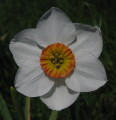
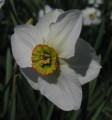


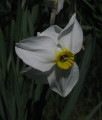
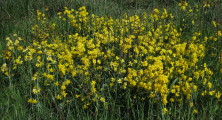

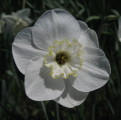
But very excellent.
Harold
Thanks Harold. I’ve had some leisure to add a few more photos. Hope they are of interest. I look forward to more of your photos and from the north side generally.
Lawrence,
Many people here in the north think that the reflex in some poets adds charm to the flower. I really don’t know anyone who faults a poet for some reflexing of the perianth. It seems to come from N. poeticus recurvus which reflexes considerably. Why do people there fault reflex in poets when we don’t fault nodding heads in cyclamineous?
Donna
Hi Donna,
Nothing I write about judging can lead to conclusions about north south differences of opinion on judging. I’m a bit out of touch. In Canberra so few poets are shown that the judges are hardly tested on the issue. I do note though that photos of champions tend to be round, overlapping and patent. Tihoi looks wonderful.
Some of the photos in Daffseek of the the parents of 13_15P, Sea Green and Cantabile, show them as slightly reflexed. N. p. hellenicus in Blanchard shows reflex as do some of the pictures of poeticus in Daffseek. I think the characteristic is more widespread than recurvus and that it could be quickly exaggerated if selected for.
For what it is worth, I have a strong view that narrow trumpets that reflex, as in cyclamineus, have forceful floral presentation when they nod and so I see this as a valuable characteristic in division 6 quite apart from this division’s relationship to species cyclamineus. It’s an interesting question as to the most forceful poise for flowers as the trumpet/cup broadens and shortens and the reflex lessens. In multi-headed flowers I like both the windswept look of reflexed tazettas and the bell-like poise of triandrus. It is probably too simple to say the more reflexed the flower the more it should nod but there is some point to it, I think.
Donna:
Excuse me for correcting a common mistake. N. poeticus recurvus‘s description has nothing to do with the tepals reflexing back. The name was applied to a plant that had leaves that bent back down to the ground. This mistake was perpetuated by ignorant nurserymen in their catalogs.
Harold